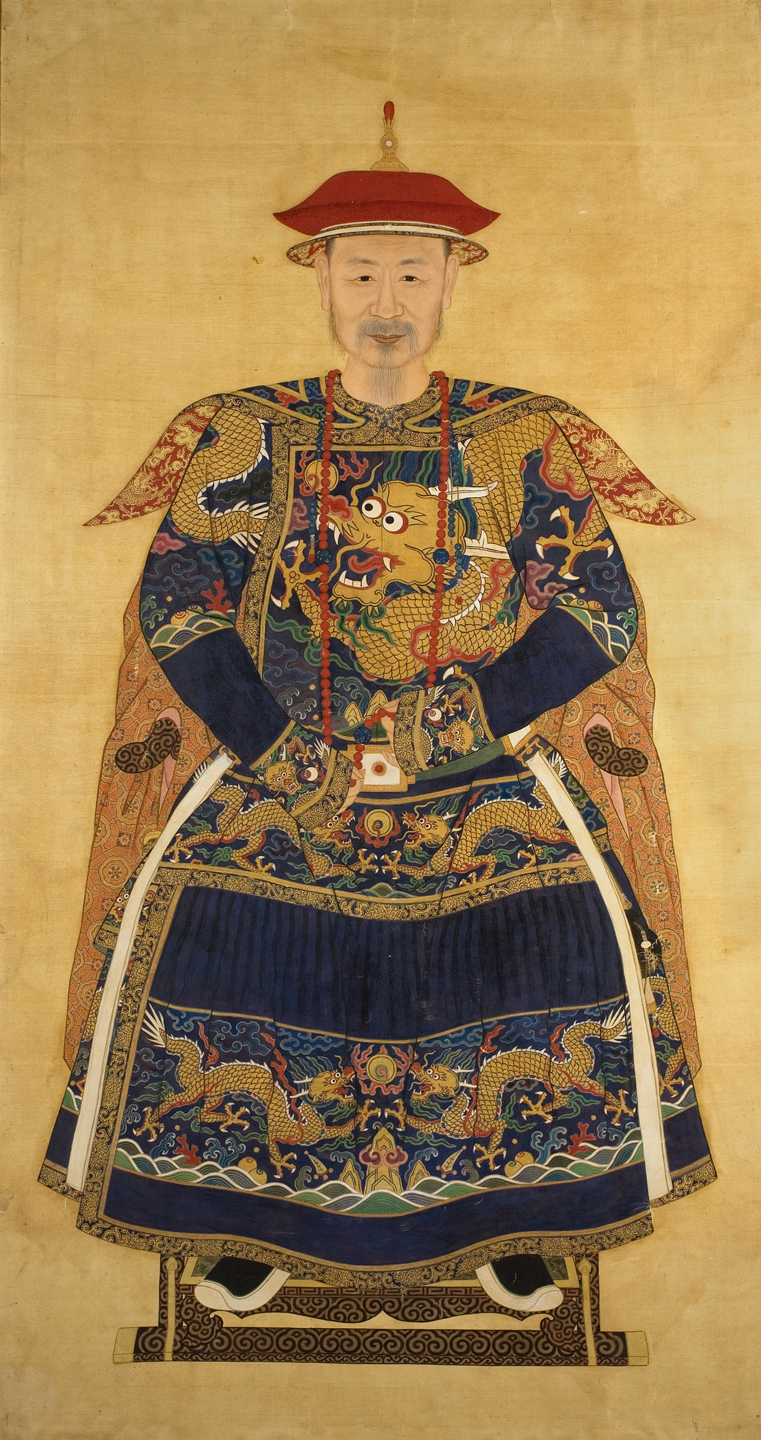Students will examine and discuss the Stela, then compare and contrast ways historical legacy is recorded. Students will read clues from the Stela, then create a bumper sticker recording something about themselves.
Students will be able to:
- describe and analyze what they see in the Stela;
- discuss symbolic meaning and intent found in a work of art;
- identify and relate connections between geographic regions and artistic representations; and
- synthesize information gained from the study of the Stela and reduce it down to a slogan.
Lesson
- Show students the Maya Stela and have them discuss what they see before you tell them any information about it. Do the carvings give any clues to what this object is about? Are any of the markings similar to something they might have seen before?
- After a brief examination and discussion, share the information from the About the Art section , paying close attention to the “Details” information.
- Discuss the origins of this work from the Classic Maya period. Relate this to any previous study of other periods of Maya civilization that might have occurred in this or other classes to link prior knowledge.
- Identify the location of former Maya city-states on a map. This area includes the Yucatan peninsula, parts of southern Mexico, Guatemala, Belize, and parts of El Salvador. Are there any clues on the Stela as to its original location? Encourage students to think of flora, fauna, or other things that might point to the geography of the area.
- Point out that this object is a relief carving taken from the walls of a building and it tells us a lot about what the patron wanted to say about his identity, beliefs, importance, wealth, and military might.
- Discuss as a class how to read this historical artifact to determine what role the man depicted played in life. Use information from About the Art to start the conversation. Some possible answers would be that he wanted to show he was a powerful military leader, his dress tells us he was wealthy and important, the glyph writing gives us information and tells us dates, and the setting lets us know he is most likely inside a small room within a temple.
- Divide students into small groups and have them discuss what they have learned about this leader by examining the Stela. We know the man wanted to leave behind this image as a monument to glorify himself and his ancestry. Ask students to think about who writes history. For the Maya, powerful leaders who could read and write recorded their civilization’s history. Who writes our history? Discuss this with the class.
- Invite students to imagine there exists an ancient Maya car and they own it. They want to jazz up their car by adding a bumper sticker that records information about themselves for posterity, just like the Stela conveys information about the leader it portrays. This is their chance to record their own history! Hand out bumper-sticker sized pieces of paper and prompt the students with questions such as: What characteristics about yourself do you want people to remember? What images or slogans convey these characteristics?
- If time allows you might wish to do more research about Maya society. You could also look at other artifacts such as the Vessel with Palace Scene and the Incense Burner with Sun God Face to gather more information.
Materials
- Map of Mexico, Central, and South America
- Note-taking paper for each student
- Paper cut in the shape of a bumper sticker
- Variety of pencils, markers, or other writing implements
- About the Art section on the Stela
- Color copies of the image for students to share, or the ability to project the image onto a wall or screen
Standards
- Social Studies
- History
- Geography
- Evaluate and analyze sources using historical method of inquiry and defend their conclusions
- Understand the concept that the power of ideas is significant throughout history
- Become familiar with Western Hemisphere historical eras, groups, individuals and themes
- Analyze the concepts of continuity and change and effect
- Analyze the concept of complexity, unity and diversity
- Become familiar with people in the world who are interconnected by geography
- Understand geographic variables and how they affect people
- Use geographic tools and sources to answer spatial questions
- Visual Arts
- Observe and Learn to Comprehend
- Relate and Connect to Transfer
- Envision and Critique to Reflect
- Language Arts
- Oral Expression and Listening
- Research and Reasoning
- Writing and Composition
- Reading for All Purposes
- Collaboration
- Critical Thinking & Reasoning
- Information Literacy
- Invention
- Self-Direction
Stela with Image of Standing Ruler Burning Offerings
Maya peoples have lived in what we now call Central America for at least three-thousand years. Their territory included parts of present-day Mexico, Guatemala, Belize, El Salvador, and Honduras. Archeologists divide the ancient Maya civilization into three major time periods: Preclassic Maya (1500 B.C.–A.D. 250); Classic Maya (A.D. 250–900); and Post Classic Maya (A.D. 900–1500).
This wall panel was created during the Classic Period, which is considered the high point of Maya culture. The Classic Maya built cities with palaces, pyramids and temples to honor their gods, and made works of art in a variety of media. They are well known for their sophisticated hieroglyphic writing system, a number system that included the concept of zero, and a calendar for recording both historical and mythological dates. Expert astronomers, the Maya observed the movements of the planets and accurately predicted eclipses.
Maya artists were specialists who produced ceramics, stone sculptures, and jewelry of jade and shell. The Maya word for artist is its’at, which means “wise man” or “sage.” Maya scribes carved inscriptions in stone, and painted them on ceramics and in books made of fig bark paper. Hieroglyphic inscriptions recorded dynastic histories, including births, deaths, and marriages. Military victories and religious ceremonies were also recorded. Like artists today, some Maya artists even signed their works.
This carved limestone slab was a wall panel from a Maya palace or administrative structure. Maya rulers commissioned stone monuments to glorify their ancestry and to proclaim their wealth, taste, military victories, and spiritual power. The image shows a Maya ruler performing an incense scattering ritual that celebrates the end of a 10 year period called a lahuntun. Along the left side of the panel, and across the top are individual signs called glyphs. The glyphs represent words or syllables that can be combined to form words. The glyphs on this panel show the date December 2, A.D. 780.
We know of two other stone carvings of this ruler, one in a private collection in Mexico, and the other in an Australian museum. These carvings suggest that he was an important ruler in his day. In both carvings, the man’s distinctive facial features are clearly identifiable and he is shown grasping prisoners by the hair.
Details
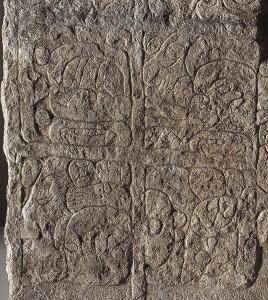
Glyphs
The hieroglyphic text forms a wall and ceiling around the figure, suggesting that he is standing inside a building. The Maya developed their own system of writing, which archeologists consider to be the most sophisticated ever developed in the Americas. The written language consists of hundreds of individual signs, called glyphs, which are paired in columns that read from left to right and top to bottom. The Maya writing system allowed room for artistic expression, so Maya glyphs are often quite elaborate. The first nine glyphs in this carving record the date; the tenth glyph is the verb; and the remaining thirteen glyphs describe the ruler. From the glyphs we know that the ruler was the master of a captive named Yax-ik’nal, and that he captured fourteen other prisoners, which suggests that he was very successful in battle. The glyphs also tell us that the ruler was at least 41 years old, and no older than 60, at the time the stela was made.
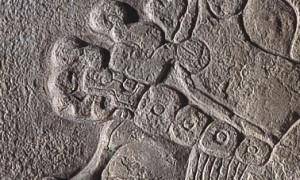
Jeweled Headband
The man in the monument can be identified as a ruler because he wears a jeweled headband around his forehead called a sac hunal, which means “resplendent one.” It is similar to a crown and would have been tied around the ruler’s head when he came to power. In the center of the headband is the head of a deity, which was usually carved in jade. The deity wears a long, three-pointed cap and is nicknamed the “jester god.”
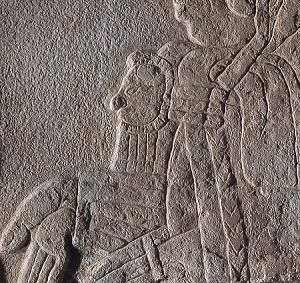
Ornaments
The ruler wears a jade ornament in the shape of a head on his chest. Long quetzal feathers decorated with jade beads fall down his back. Both of these ornaments are signs of his powerful status.
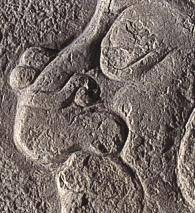
Distinctive Facial Markings
Notice the figure’s heavily lidded eye, the swirling line on his nose that could be a facial scar, and jade bead ornaments on his nose.
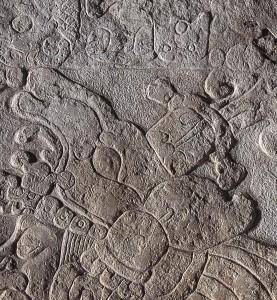
Headdress
On top of the ruler’s headband sits a jaguar head. Above that is the glyph ak’bal, which means “darkness.” Smoke or fire rises out of the ak’bal glyph.
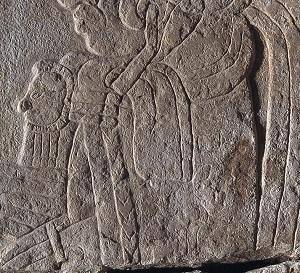
Clothing
The man wears a knotted scarf around his neck and a long cape decorated with three human eyes. Both of these are part of the special clothing the Maya wore when performing sacrificial rituals.

Incense Bag
In this ritual, the ruler is shown scattering incense. His left hand holds a long bag containing the incense, and his right hand is in the scattering gesture. At his feet is a large basket containing long strips of paper and a small tied bundle.

Empty Space
The empty space between the figure and the glyphs emphasizes the outline of the figure, particularly in the areas around his face and headdress.
Funding for object education resources provided by a grant from the Morgridge Family Foundation. Additional funding provided by the William Randolph Hearst Endowment for Education Programs, and Xcel Energy Foundation. We thank our colleagues at the University of Denver Morgridge College of Education.
The images on this page are intended for classroom use only and may not be reproduced for other reasons without the permission of the Denver Art Museum. This object may not currently be on display at the museum.





